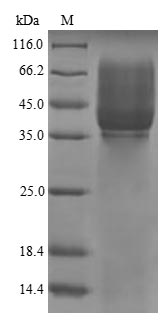Recombinant Pig Cadherin-3 (CDH3) is produced in a yeast expression system and carries an N-terminal 6xHis-sumostar tag. The protein spans the complete 1-145 amino acid sequence, which appears to provide thorough structural coverage. SDS-PAGE analysis shows purity levels exceeding 90%, suggesting it's well-suited for research applications. This product is meant exclusively for research purposes—not for diagnostic or therapeutic use.
Cadherin-3, also called CDH3, belongs to the classical cadherin family of proteins that mediate cell-cell adhesion. It plays what seems to be a central role in maintaining tissue structure and cellular communication. The protein is likely involved in pathways controlling cell growth, differentiation, and movement. Research into how Cadherin-3 interacts with other molecules and how it's regulated may offer important clues about development and tissue healing, which is why cell biologists focus considerable attention on it.
Potential Applications
Note: The applications listed below are based on what we know about this protein's biological functions, published research, and experience from experts in the field. However, we haven't fully tested all of these applications ourselves yet. We'd recommend running some preliminary tests first to make sure they work for your specific research goals.
Based on the provided information, recombinant pig CDH3 is produced in a yeast expression system as a protein fragment (1-145aa) with an N-terminal 6xHis-SUMOSTAR tag, representing only the N-terminal extracellular portion of the full-length cadherin (which typically includes transmembrane and cytoplasmic domains). Yeast expression systems provide eukaryotic folding machinery that can support disulfide bond formation and potential glycosylation, which are important for cadherin function. However, CDH3 is a calcium-dependent adhesion protein that requires precise folding of its extracellular domains for biological activity. The large SUMOSTAR tag may sterically interfere with proper folding or function. Purity >90% by SDS-PAGE is determined under denaturing conditions and does not confirm native folding or bioactivity. No validation data (e.g., calcium binding assays, cell adhesion tests) are provided. Therefore, while yeast expression increases the probability of correct folding compared to prokaryotic systems, the protein's folding status and bioactivity cannot be confirmed without experimental validation.
1. Antibody Development and Validation Studies
This recombinant CDH3 fragment can be used as an immunogen for antibody generation, as antibody development primarily relies on linear epitope recognition, which is independent of folding status. The high purity and defined sequence support consistent immunization results. However, if correctly folded, antibodies may recognize conformational epitopes relevant to native CDH3; if misfolded, generated antibodies might not optimally bind the full-length protein in biological contexts, limiting utility for functional studies. The His-SUMOSTAR tag facilitates purification but may also elicit tag-specific antibodies.
2. Protein-Protein Interaction Studies
If the CDH3 fragment is correctly folded, the His-tag enables pull-down assays to identify binding partners, as proper folding is essential for biologically relevant homophilic or heterophilic interactions typical of cadherins. However, if misfolded, interaction domains may be altered, leading to non-specific binding or failure to recognize genuine partners, compromising the validity of identified networks. The fragmentary nature (1-145aa) may also lack full interaction capabilities of the complete extracellular domain.
3. Biochemical Characterization and Structural Studies
If properly folded, the fragment is suitable for biophysical studies like circular dichroism or thermal stability assays to analyze domain-specific properties. However, if misfolded, structural data would misrepresent the native protein's architecture, and the partial nature limits insights into full-length CDH3 behavior. The large tag may interfere with structural analyses and should be removed for detailed studies.
4. Cell Adhesion Assay Development
If correctly folded and functional, the recombinant CDH3 could serve as a coating substrate for cell adhesion assays, as it may retain calcium-binding and adhesion properties. However, if misfolded, it will not mediate specific cell adhesion, leading to false-negative results. The tag may also affect protein orientation and function on assay plates, reducing physiological relevance.
Final Recommendation & Action Plan
Before employing this recombinant CDH3 fragment in any application, it is essential to validate its folding and bioactivity through biophysical methods (e.g., circular dichroism for secondary structure, calcium binding assays) and functional tests (e.g., cell adhesion assays with appropriate controls); if validation confirms proper folding, proceed with applications while noting the limitations of the partial fragment and large tag; if misfolded, consider using full-length CDH3 expressed in mammalian systems for better physiological relevance or obtain a commercially validated standard; for immediate use, antibody development can proceed with the understanding that antibodies may require additional validation against native protein, but avoid functional studies until proper folding and bioactivity are conclusively demonstrated.






